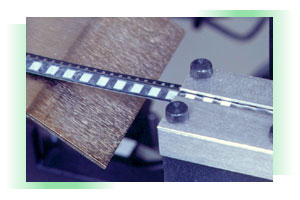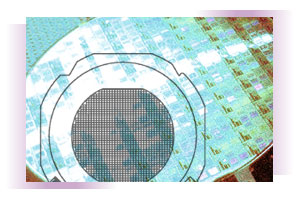|
Carrier Options
Pros and Cons of using various forms of Die transportation
There are various forms in which Die product can be shipped. The easiest from an IR manufacturing point of view, is probed un-sawn wafers. For customers with their own Die saw capability, this may be the preferred solution as storage and handling are relatively easy.
For low volumes, Die in Waffle tray / chip pack may be the best solution, where manual handling is often used.
For medium volumes Film Frame maybe the best solution.
In the case of higher volumes a Tape and Reel solution is used in Pocket Tape form. The cost overhead for setting up a facility to handle Tape and Reel is somewhat higher than with the other shipping solutions, however the actual ‘assembly’ costs could be somewhat lower as there is a higher level of automation.
Each Customer and Customer application, will be different and so the generalizations used above may not be applicable.
IR supports un-sawn Probed wafer, Waffle Trays and Film on Frame as standard, with Pocket Tape, Surf Tape and Gel Pack as options.
 Waffle Tray / Chip Pack
Waffle Tray / Chip Pack
 Film Frame
Film Frame
 Pocket Tape
Pocket Tape
The links above direct you to a detailed analysis of the Pros and Cons of the various shipping methods
| Pros |
Cons |
- Trace ability good
- Die can be sealed into a controlled environment, longer shelf life
- Good for KGD processing and bumped die, bumps up or down
- Most pick/place equipment is designed for carrier tape, industry standard for more then one component
- Very good for high volume and throughput
- Quick change over for more material/different lots
- Very flexible for die orientation
- Difficult to mix product
- Vacuum pick up required
- Can store left over material without effecting product
- Most pick and place systems have multiple feeders very good for MCM components variations
- Die are very secure to prevent operator caused damage
- Packaging very flexible for die sizes and reel diameters
- Standard counts for packing/inventory control
- Process allow for blind pick up
- Can recycle reels but is very affordable to discard
- No push pins
- Easy to remove from pockets only requires vacuum pick up
- Shipping storage and handling of pocket very friendly
- Exact die counts
- Set pick up place
|
- Can require NRE for tooling
- Loose tolerances x-y-theta
- Not good for low volumes/engineering samples
- Requires more up front design work/NRE adder
- Requires removing reel feeder to store in N2 if reel is not finished
- Selected pick and place equipment
- Requires feeder for each different reel for pitch/ width/ depth.
- Die Placement accuracy might not meet customer/process requirement. Would require vision alignment for placement requirements of less +/- .005 and 10 degrees theta rotation

Tape and Reel Illustration |
| Pros |
Cons |
- Can use one tray for different die sizes
- Packaging friendly
- Standard counts for packaging/inventory control
- Process allow for blind pick up
- Capable for KGD processing
- Does not required pattern recognition
- Flexible packing, 1-5-10 trays
- Can recycle trays but costs also make it affordable to discard
- No push pins
- Easy to remove from trays only requires vacuum pick up
- Comes in 2x2 or 4x4 trays
- Shipping, storage and handling of product very friendly
- Exact die counts
|
- Loose tolerances required for x-y
- Can have theta rotation of die
- Might require NRE tooling for some die-tray sizes
- Limited pocket sites for large die
- If packing material is recycled requires cleaning before reusing, cost adder
- Process allows that operator can drop a tray causing damage contamination, Mix product, yield loss
- Selected pick and place equipment
- Requires higher costing add-in features for selected equipment which affects throughput due to more movements by the product or the system
- Without automatic tray feeders will require more frequent material changes which could severely affect throughput, since it would be operator depended
- If receiving both 2x2 or 4x4 tray would requires a change over for either the tooling/handler or both
- Requires higher cost, feeders/stackers for automatic tray changer (trays in/out)
- Would require flipping tooling/system for bump die
- Die Placement accuracy might not meet customer/process requirement. Would require vision alignment for placement requirements of less +/- .005 and 10 degrees theta rotation
- Possibility to mix product
Waffle Pack Illustration |
| Pros |
Cons |
- Exact repeatability from die to die for x-y-theta
- Cassette to cassette handling in/out of system or manual
- Good trace ability
- No mix of die to die
- Very flexible packaging
- No NRE tooling costs for new product or die sizes
- Can recycle frames/shipping boxes but is affordable to discard
- Can color code frames (none ESD)

|
- Individual shipment of wafer, requires more storage space
- Not capable for KGD processing
- Quantity of shipment based on estimation of GDPW
- If packing material is recycled requires cleaning before reusing, cost adder
- Adherence problem for large die must us low tack or UV tape
- Selected pick and place equipment
- Higher cost for feature adders in selected equipment
- Requires wafer expansion
- Requires theta alignment of wafer
- Requires push pins
- Requires pattern recognition for ink dots
- Would require flipping tooling / system for bump die
- Affects throughput due to wafer movement
Film Frame Illustration |
|